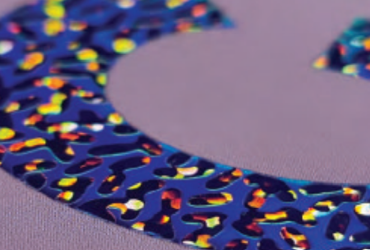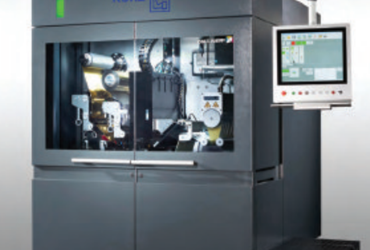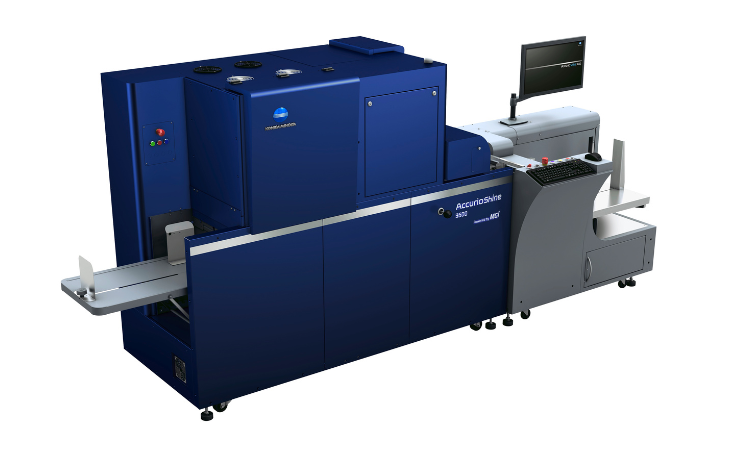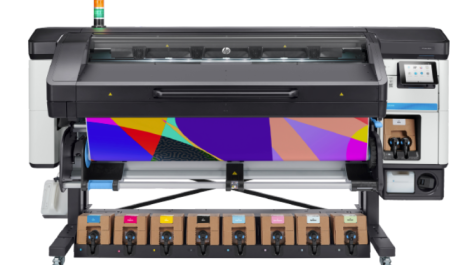What was once called special effects and is now embellishment offers vast potential for stunning new creative effects, but can also add value and help to avoid digital print following colour offset in a race to the bottom in pricing, says Simon Eccles
The term ‘embellishment’ can encompass inline printed effects such as metallic, pearlescent or fluorescent inks, or post-press processes such as raised and textured effects – sometimes called ‘tactile’ or ‘haptic’ – plus a wide variety of foiled effects that can range from mirror-bright metallics through diffraction and holographic effects, or just special colours.
A lot of the recent action has been over the Atlantic, but much of it is relevant to the UK and Europe. September saw the existing US based Foil & Specialty Effects Association (FSEA) announce the formation of the more focused Digital Embellishment Alliance (DEA), which it describes as a community to create educational and communication opportunities in the growing digital print embellishment segment.
This followed a three-day event in June in Minneapolis called Amplify Print, organised by the FSEA and APTech, which highlighted digital embellishment.
‘In the world of digital print embellishments, we see a market that is on the cusp of going mainstream but still suffers from an awareness issue at the brand and designer level,’ explained Gene Petrie, chair of the FSEA board of directors. ‘A key aim of the DEA is to help users and manufacturers educate their customers and increase understanding of how these digital embellishment technologies can help brands increase their print ROI.’ This year’s LabelExpo in Chicago, the first one to be held since the 2019 show in Brussels, featured a Digital Embellishment Trail for the first time, where stands featuring these effects were flagged up.
While the market for label embellishment is different to commercial printing and packaging, it’s also an indicator of which way the wind is blowing. It’s also worth mentioning Actega’s unique EcoLeaf filmless foiling technology, so far only for narrow web label presses, which applies metallic nanoflakes to a special inkjetted fluid to give a mirror-smooth metallic finish with no waste.
Inline on presses
Digital presses increasingly offer fifth and even sixth units that can take a variety of special toners, some to extend the colour gamut and some to add embellishments such as metallics, spot gloss or other effects. Kodak was the first to really make a go of this in 2008 with the fifth unit on its second-generation Nexpresses, which not only offered a wide range of special colours but could build up a raised ‘dimensional’ embossed effect with clear toner.

An example of the effects achievable with the combination
of digital spot UV and foiling on Duplo’s DuSense 8000
This has been continued with the latest Nexfinity models, whose fifth unit can produce 13 effects, including gold, silver, dimensional or gloss clear, and an opaque white. Xerox has also offered extra colours for years, most notably with its Iridesse model, which as the name suggests majors on its special effects abilities. Iridesse is still the only dry toner press to offer six colour stations, though HP Indigo liquid toner presses can have up to seven. Iridesse can run special toners in the first and sixth, or fifth and sixth positions – you might choose white in the first position as an undercoat on clear, dark or metallised substrates. Special toners can be white, clear (high or low gloss), fluorescent pink, gold or silver. The past few years have seen Xerox introduce add-on embellishment options as ‘Adaptive CMYK+’ kits for the mid-production Versants and the entry-level PrimeLink C9065/C9070.
These allow users to swap out the CMYK cartridges for a second embellishment pass. There’s a choice of ‘Vivid’ (silver, gold, white and clear, or fluorescent (cyan, magenta yellow, plus normal black). These can be fitted aftermarket if needed. Switching between toner sets takes 10 minutes or so, but Xerox Europe’s head of marketing Kevin O’Donnell says that it allows smaller printers to broaden their offerings and keep embellishment work inhouse. The high end iGen 6 has a fifth unit too, which gained a new fluorescent yellow toner option last year, alongside white, clear and some Pantone specials. Ricoh’s Pro C7200sx series toner presses have an inline fifth unit that can run white, clear, neon yellow, neon pink and ‘invisible’ security red.
White can run as the first colour if needed as an undercoat. HP Indigo digital presses are still unique in the way they can run up to seven colours with easy swapping. ‘Special’ inks include two white types, gloss and matt clear, silver, fluorescents (green, orange and pink), plus gamut[1]extending and tone-smoothing colours. Xeikon is developing a range of embellishment modules for its web toner presses that it calls Fusion; at LabelExpo it demonstrated an opaque white and silver printing on clear film. Foiling with laminators The post-press ‘sleeking’ market of foil embellishment via lightly modified thermal laminators makes a very attractive entry level for jobs where metal dies aren’t cost-effective. Several laminator suppliers promote this in the UK.
The results may not be as sharp as metal dies or the expensive inkjet foilers, but the entry costs are very low indeed, especially as the machines still work for conventional lamination, as with D&K’s range which foils up to B2. The Korean manufacturer GMP pioneered laminators with foiling facilities and sells three via GMP UK, a part of Gardiner Graphics. Intec Printing Systems – recently bought by Plockmatic and now sold alongside Morgana in the UK – bases its pair of ColorFlare foil laminators on GMP hardware: the CF350 costs £1999 and the CF1200 starts from £7999.
It also sells compatible foils, which were recently extended with a fashionable rose gold colour, plus copper and a useful opaque white. Vivid Lamination also offers a special Matrix Metallic version of its popular 420mm wide sheet-fed thermal laminator, for spot foils and gloss effects. This features modified rollers and a foil feeder. Other suppliers of laminator with foiling options include Autobond, Foliant (sold by IFS, using the retrofittable Multi-functional Imprinting Unit) and Komfi (sold by Friedheim). It was Caslon who pioneered the foil-onto-toner market in the 1980s, using dedicated heater-applicators rather than laminators. The company currently sells US-built FoilTech. machines, starting about £2000 for a 340mm wide manual feed model, up to a bit over £4000 for an auto-feed twin ribbon machine. A much more expensive but faster option is Kurz’s dedicated 4000sph B1 digital DM-Luxliner, which foils directly onto dry toner or HP Indigo prints.
Inkjets for ultimate effects
Inkjet-based embellishers have tended to get all the publicity ever since MGI announced JetVarnish, a digital spot UV varnisher, at drupa 2008 (though so did Komfi, but with less fanfare). At Ipex 2010 Scodix showed the first ‘high-build’ inkjet UV varnisher, with a raised and textured effect.
MGI soon followed with a high-build model called JetVarnish 3D. A few years later both worked out how to apply foil over the raised clear polymer. Scodix still offers more effects though, including faceted gems and Cast & Cure for high-end packaging. Scodix has gone through several generations and today has standardised on the Ultra 1000 series, with six models ranging in price from about £400,000 to £1.1 million. Most of them are B2 format, but with different front end configurations for commercial print, web-to-print and carton packaging.

Kurz offers high-end digital foiling options
supporting sheet sizes up to B1
There are two configurations for most applications. The base model uses a single polymer type, which VP global sales and marketing manager Mark Nixon says is suitable for ‘75% of all possible jobs.’ The other type has four polymer feeds, with different characteristics formulated between them to adhere to pretty well any substrate. The top model is the Ultra 6000, the only current B1 format offering, with a top speed of 1000sph. There was briefly a 4000sph B1 model, the E106, but the £2 million-plus price was too much for the market to bear. Mr Nixon says that users are happy with 1000 sph, as it compares favourably with high end analogue foiling systems that use metal dies and which can take hours to make ready. MGI today is in effect a subsidiary of Konica Minolta which as of October 202 held a 42.3% stake. KM sells the range worldwide, though not exclusively. Three models are B2 format, offering up to 4200sph, one is roll-to-roll on a 420mm web, and there is a long-A3 format model that was originally called JetVarnish 3D One, which was exclusive to KM even before it increased its shareholding in MGI.
This summer the MGI-badged One has been replaced by the Konica Minolta-branded AccurioShine 3600, which is apparently the same thing with a different colour scheme, though there may be technical differences we haven’t found out yet. MGI’s enormous B1 AlphaJet, which is now available after years of development and previews, can print full p The Konica Minolta-branded AccurioShine 3600 replaces the MGI JetVarnish 3D One colour and embellish with 3D polymer and foil inline at 1800sph. So far there’s only one user, ISRA, in France, announced this year. An official launch is due in October and will be reported in Digital Printer. At LabelExpo 2019, a prototype digital cutting and creasing unit was demonstrated that may find its way onto the AlphaJet too. Germany’s foil manufacturer Kurz recently acquired the Swiss Steinemann company, whose inkjet varnish and foiling systems it was already marketing as Digital Metal. These include the sheetfed B2 DM-Smartliner for 2D flat varnishing and overfoiling and the DM-Maxliner for raised and textured effects. There are also narrow web label models. Duplo’s B3 DuSense 810 is probably the entry level for 3D varnish effects.
Duplo is very resistant to giving prices, but the launch price in 2017 was reportedly £139,000. That’s a lot less than any of the current MGI or Scodix machines, though Konica Minolta’s AccurioShine 3600 may be in the same price league. DuSense can be fitted with optional inline foiling using the Bagel MiniLam lamination/foil unit. There is now also a B2 model, the DuSense 8000, launched in May 2022, which is offered in various configurations providing the spot UV, digital foiling or both, including a pre-treatment option for expanding the types of print that can be handled.
How to sell it
With embellishment systems becoming relatively common, at least as options, the challenge is now how to get the message out to the customers – designers, brands, even high street shops, who won’t order effects that they don’t realise exist. Xerox is well aware of this, says Kevin O’Donnell, and is making a big push to support help its users develop their markets for the embellishment options on their presses. Its Genesis Initiative is a multi-level set of free offerings that aim to build the market for what it calls ‘beyond CMYK.’ This includes helping printers to market embellishment effectively, and also to understand how to price it. There are also courses for designers to learn about embellishment, and how to use it and explain it to their customers too. Mr O’Donnell says ‘The key is not just the technology. More important is market engagement, and design skills. Every printer should be looking at the ‘plus’, over and above the norm. That’s not just embellishment, but anything you can do to stand out from the crowd, even if it’s just giving a box of doughnuts to new customers! ‘Embellishment might be priced for profitable value-added business, or it might equally be priced as a loss-leader to get new business,’ he says.
‘Some 90 – 95% of your business might always be CMYK, but if the embellishment brings in new customers, you’ve got a good chance of retaining them for future CMYK work.’ Another separate initiative is what’s probably the first consultancy intended specifically at helping creatives and producers get the best out of digital embellishment. Taktiful in California has been set up by Kevin Abergel, who worked for many years for MGI. He was most recently sales director for North America, but that office closed when Konica Minolta took on sales and distribution.
He’s now established a network of consultants with practical experience of digital embellishment in North America, and is looking to expand his services into Europe and the UK soon. He’s not confining his work to MGI/Konica Minolta based systems, but across the whole range of processes and manufacturers. He says that digital embellishment systems aren’t being sold enough to customers, especially the built-in fifth units on digital presses. ‘People aren’t selling it correctly, they aren’t necessarily understanding how to pitch it or how to teach their clients how to design for it. A lot of the clients we work with at Taktiful have a fifth colour and say, ‘Yeah, I never use it. It’s just sitting there’, or ‘I’ve had this machine for two years. Maybe I’ve run 10 jobs on it’.
Overall, you ask them what percentage of jobs are they actually using it on. Typically they say less than four or five per cent. It’s a nice-to-have, but right now it’s not a need to-have because they’re not actually putting in a lot of the marketing effort needed to be able to take that off the ground. ‘But then we see some small mom and pop companies, little three, four-person shops, and embellishment is all they talk about. They go around, they talk to every restaurant, every little trophy shop or every little shoe store. They talk about how great the print could look. They say, ‘You could put in this fluorescent green on your next mailing, or let’s put in some dimensional on your menu so that you can actually feel the wood grain’. These are the people who get it and they’re the ones that are making it work for them.’





